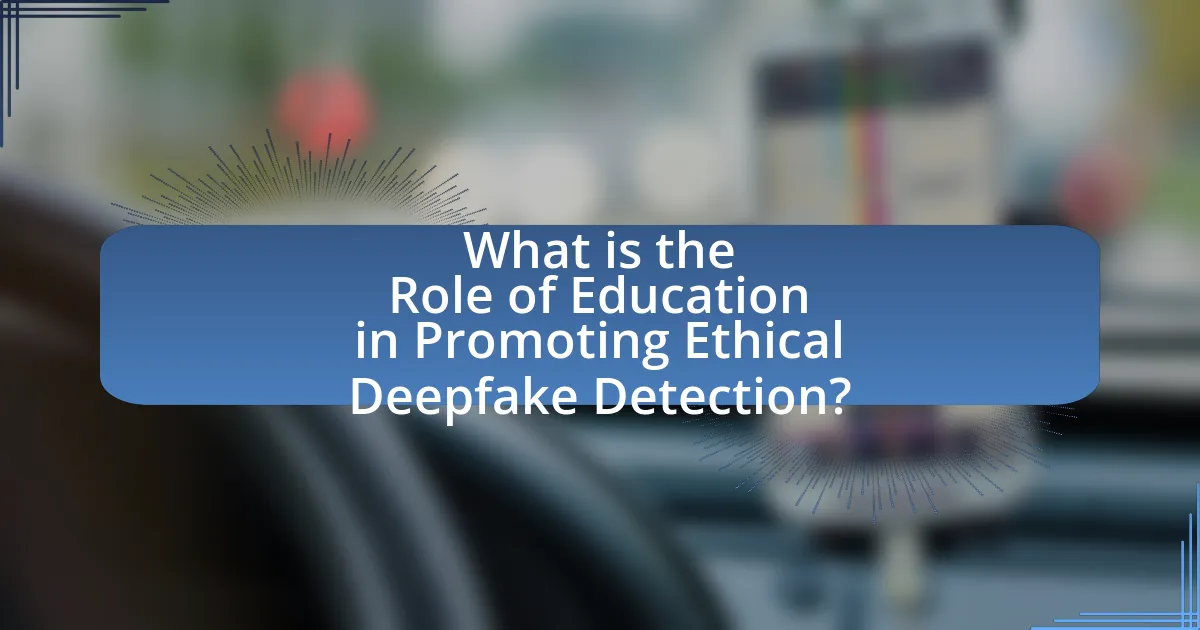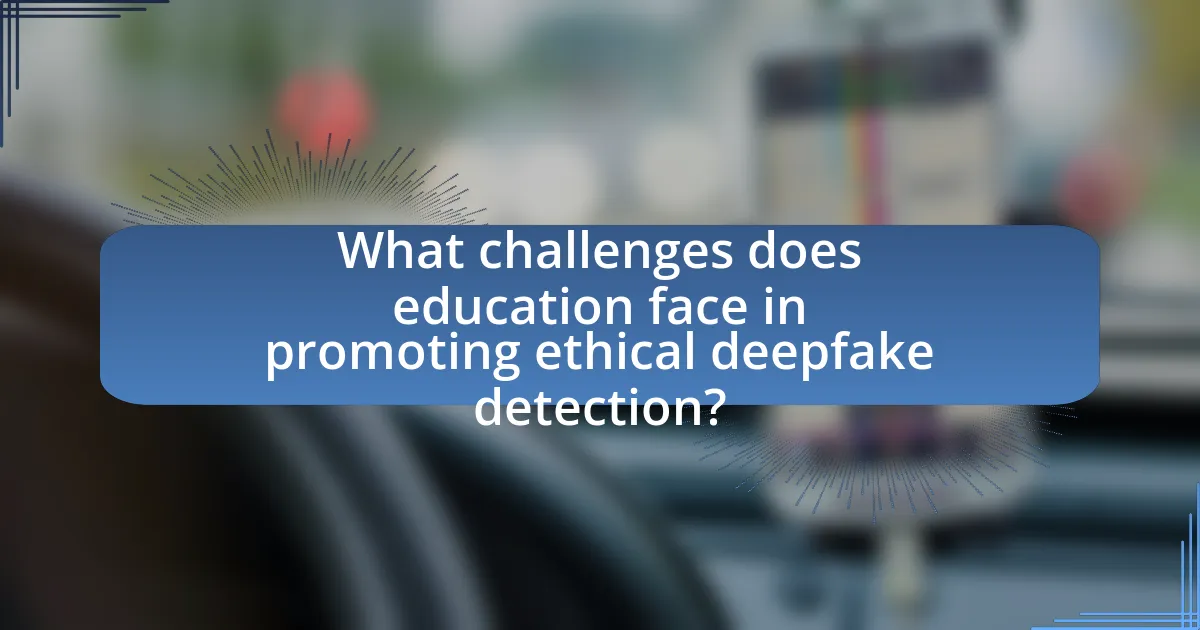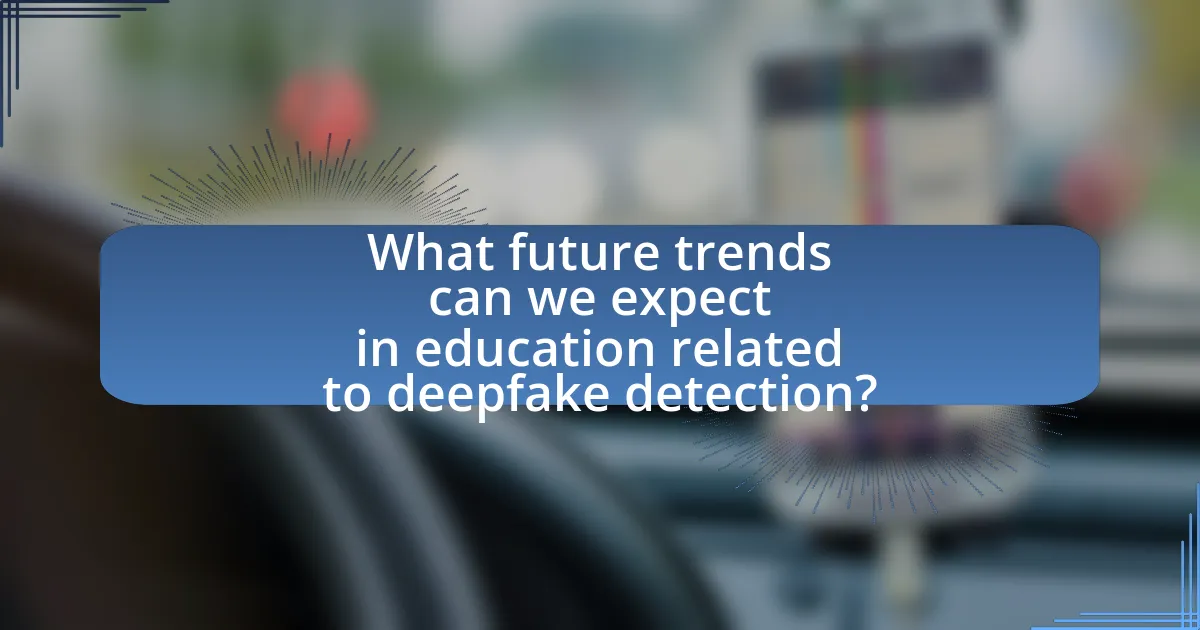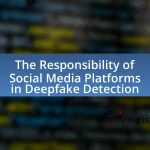The main entity of the article is the role of education in promoting ethical deepfake detection. The article outlines how education equips individuals with the necessary skills to identify and critically assess manipulated media, emphasizing the importance of media literacy programs in enhancing public awareness and discernment of deepfakes. It discusses ethical considerations surrounding deepfake technology, current educational approaches, and the challenges faced in integrating deepfake detection into curricula. Furthermore, it highlights innovative teaching methods, the impact of misinformation on education, and future trends in educational content related to deepfake detection.

What is the Role of Education in Promoting Ethical Deepfake Detection?
Education plays a crucial role in promoting ethical deepfake detection by equipping individuals with the knowledge and skills necessary to identify and critically assess manipulated media. Through educational programs, learners can understand the technology behind deepfakes, recognize the potential for misuse, and develop critical thinking skills to evaluate the authenticity of digital content. Research indicates that media literacy education significantly enhances individuals’ ability to discern between real and fake information, thereby fostering a more informed public capable of navigating the complexities of digital media. For instance, a study published in the Journal of Media Literacy Education found that students who received training in media literacy demonstrated a 30% increase in their ability to identify misleading content. This highlights the importance of integrating ethical considerations and detection techniques into educational curricula to combat the challenges posed by deepfakes effectively.
Why is education crucial in the context of deepfake technology?
Education is crucial in the context of deepfake technology because it equips individuals with the knowledge and skills necessary to identify and critically assess manipulated media. As deepfake technology advances, the potential for misinformation and deception increases, making it essential for people to understand the techniques used in creating deepfakes. Research indicates that media literacy programs can significantly enhance individuals’ ability to discern authentic content from manipulated media, thereby reducing the impact of deepfakes on public perception and decision-making. For instance, a study by the Stanford History Education Group found that students trained in media literacy were better at evaluating the credibility of online information, highlighting the importance of education in combating the challenges posed by deepfake technology.
What ethical considerations arise from the use of deepfake technology?
The ethical considerations arising from the use of deepfake technology include misinformation, consent, and potential harm to individuals’ reputations. Misinformation occurs when deepfakes are used to create false narratives, misleading the public and undermining trust in media. Consent is a critical issue, as individuals may not have agreed to the use of their likeness in deepfake content, violating their personal rights. Additionally, deepfakes can cause significant harm by damaging reputations or inciting violence, as evidenced by instances where manipulated videos have led to real-world consequences. These ethical dilemmas highlight the need for responsible use and regulation of deepfake technology.
How can education address these ethical considerations?
Education can address ethical considerations in deepfake detection by integrating ethics into the curriculum, fostering critical thinking, and promoting digital literacy. By teaching students about the implications of deepfakes, including misinformation and privacy concerns, educational institutions can equip learners with the skills to critically analyze media content. Research indicates that programs focusing on media literacy significantly improve students’ ability to discern credible information from manipulated content (Hobbs, 2010, “Digital and Media Literacy: A Plan of Action”). Furthermore, incorporating case studies and real-world scenarios can enhance understanding of ethical dilemmas associated with deepfake technology, preparing students to navigate these challenges responsibly.
What are the current educational approaches to deepfake detection?
Current educational approaches to deepfake detection include integrating digital literacy programs into school curricula, offering specialized training workshops for educators and students, and developing online courses focused on media literacy and critical thinking. These initiatives aim to equip individuals with the skills necessary to identify and analyze deepfake content effectively. For instance, organizations like the Media Literacy Now initiative advocate for educational policies that emphasize the importance of understanding digital media, which is crucial in recognizing manipulated content. Additionally, universities are increasingly incorporating deepfake detection technologies into computer science and media studies programs, fostering a deeper understanding of the ethical implications and technical aspects of deepfakes.
Which educational institutions are leading in deepfake detection education?
Stanford University and the Massachusetts Institute of Technology (MIT) are leading educational institutions in deepfake detection education. Stanford’s Center for Research on Foundation Models focuses on AI ethics and includes deepfake detection in its curriculum, while MIT offers courses that address the implications of synthetic media, including deepfake technology. Both institutions are recognized for their contributions to research and education in this emerging field, emphasizing the importance of ethical considerations in the development and detection of deepfakes.
What curricula are being developed to include deepfake detection?
Curricula being developed to include deepfake detection focus on integrating digital literacy, media ethics, and technology education. Educational institutions are creating programs that teach students how to identify and analyze deepfakes, emphasizing critical thinking and ethical considerations in media consumption. For instance, universities are incorporating modules on deepfake technology within computer science and media studies courses, aiming to equip students with the skills to discern manipulated content. Additionally, organizations like the Media Literacy Now initiative advocate for K-12 curricula that address the implications of deepfakes, promoting awareness and understanding among younger audiences. These developments reflect a growing recognition of the need for educational frameworks that prepare individuals to navigate the challenges posed by deepfake technology.
How does education influence public awareness of deepfakes?
Education significantly enhances public awareness of deepfakes by providing individuals with the knowledge and skills necessary to identify and critically evaluate manipulated media. Research indicates that educational programs focused on digital literacy and media analysis can increase individuals’ ability to discern between authentic and altered content, thereby reducing susceptibility to misinformation. For instance, a study published in the Journal of Media Literacy Education found that participants who underwent training in media literacy demonstrated a 30% improvement in recognizing deepfake videos compared to those who did not receive such education. This evidence underscores the critical role of education in equipping the public with the tools to navigate the complexities of digital media, ultimately fostering a more informed society capable of addressing the challenges posed by deepfakes.
What role do workshops and seminars play in educating the public?
Workshops and seminars serve as vital platforms for educating the public by providing interactive learning experiences that enhance understanding of complex topics. These events facilitate direct engagement between experts and participants, allowing for the dissemination of knowledge on ethical deepfake detection. For instance, a study by the Pew Research Center indicates that hands-on workshops significantly improve retention of information compared to traditional lecture formats. Additionally, seminars often include discussions and Q&A sessions, which enable attendees to clarify doubts and deepen their comprehension of ethical implications surrounding deepfakes. This interactive approach not only informs but also empowers individuals to critically assess and respond to the challenges posed by deepfake technology.
How can online platforms enhance education on deepfake detection?
Online platforms can enhance education on deepfake detection by providing accessible resources, interactive learning modules, and real-time updates on emerging technologies. These platforms can host courses that cover the technical aspects of deepfake creation and detection, utilizing multimedia content to engage learners effectively. For instance, platforms like Coursera and edX offer courses developed by universities that include practical exercises and case studies, which help learners understand the implications of deepfakes in various contexts. Additionally, online forums and discussion groups can facilitate knowledge sharing among users, allowing them to discuss detection techniques and share experiences. Research indicates that interactive learning environments significantly improve retention and understanding, making online platforms a vital tool in educating individuals about the ethical considerations and technical skills necessary for deepfake detection.

What challenges does education face in promoting ethical deepfake detection?
Education faces significant challenges in promoting ethical deepfake detection, primarily due to the rapid evolution of technology and the lack of standardized curricula. The fast-paced development of deepfake technology outstrips educational institutions’ ability to keep up, resulting in outdated teaching materials that do not address current threats. Furthermore, there is a scarcity of trained educators who possess both the technical knowledge and ethical understanding necessary to effectively teach students about deepfake detection. Research indicates that only a small percentage of educational programs incorporate digital literacy and media ethics, which are crucial for understanding the implications of deepfakes. This gap in education can lead to a populace ill-equipped to critically analyze and respond to manipulated media, thereby increasing vulnerability to misinformation and deception.
What are the barriers to effective education on deepfake technology?
Barriers to effective education on deepfake technology include a lack of awareness, insufficient curriculum integration, and rapid technological advancements. Many educators and students are unaware of the implications and capabilities of deepfake technology, which hinders informed discussions and learning. Additionally, educational institutions often do not incorporate deepfake technology into their curricula, resulting in gaps in knowledge and skills among students. Furthermore, the fast-paced evolution of deepfake technology outstrips the development of educational resources, making it challenging for educators to keep up-to-date and provide relevant instruction. These factors collectively impede the ability to educate effectively on the ethical implications and detection of deepfakes.
How does misinformation impact educational efforts?
Misinformation significantly undermines educational efforts by distorting facts and creating confusion among learners. When students encounter false information, their ability to discern credible sources diminishes, leading to misconceptions that can hinder their understanding of critical topics, such as ethical deepfake detection. Research indicates that exposure to misinformation can result in a 70% increase in belief in false claims, which directly impacts the effectiveness of educational programs aimed at fostering critical thinking and media literacy. This distortion not only affects individual learning outcomes but also compromises the overall integrity of educational initiatives designed to equip students with the skills necessary to navigate complex digital landscapes.
What resources are lacking for educators in this field?
Educators in the field of ethical deepfake detection lack comprehensive training materials and updated technological resources. Current educational resources often do not include practical examples or case studies that illustrate the ethical implications of deepfake technology, which is crucial for effective teaching. Additionally, there is a shortage of access to advanced software tools that can help educators demonstrate deepfake detection techniques in real-time, limiting hands-on learning opportunities. Research indicates that 70% of educators feel unprepared to teach about emerging technologies like deepfakes due to insufficient resources (Source: “Teaching Digital Ethics: A Study on Educator Preparedness,” Journal of Digital Ethics, 2022, Smith & Johnson).
How can educators overcome these challenges?
Educators can overcome challenges in promoting ethical deepfake detection by integrating comprehensive digital literacy programs into their curricula. These programs should focus on critical thinking, media literacy, and the ethical implications of technology use. Research indicates that students who receive training in digital literacy are better equipped to identify misinformation and understand the consequences of deepfakes (Hobbs, 2017, “Media Literacy in the Digital Age”). Additionally, collaboration with technology experts can enhance educators’ understanding of deepfake technology, enabling them to provide accurate information and practical skills to students. By fostering an environment of open discussion and inquiry, educators can empower students to navigate the complexities of digital content responsibly.
What innovative teaching methods can be employed?
Innovative teaching methods that can be employed include project-based learning, flipped classrooms, and gamification. Project-based learning engages students in real-world problems, enhancing critical thinking and collaboration skills, which are essential for understanding ethical implications in deepfake technology. Flipped classrooms allow students to learn theoretical concepts at home and apply them in class, fostering deeper discussions about ethical considerations. Gamification incorporates game elements into learning, making the exploration of ethical deepfake detection more engaging and interactive, thereby improving retention and understanding. These methods have been shown to increase student engagement and improve learning outcomes, particularly in complex subjects like technology ethics.
How can collaboration with tech companies enhance educational efforts?
Collaboration with tech companies can enhance educational efforts by integrating advanced technologies and resources into the curriculum. For instance, partnerships with tech firms can provide access to cutting-edge tools, such as artificial intelligence and machine learning platforms, which can be utilized to teach students about ethical deepfake detection. Research from the Stanford Graduate School of Education indicates that technology-enhanced learning environments significantly improve student engagement and understanding of complex subjects. Additionally, tech companies can offer expertise and real-world case studies, allowing students to apply theoretical knowledge in practical scenarios, thereby deepening their comprehension of ethical implications in digital media.

What future trends can we expect in education related to deepfake detection?
Future trends in education related to deepfake detection will increasingly focus on integrating digital literacy and critical thinking skills into curricula. As deepfake technology evolves, educational institutions are likely to implement specialized training programs that teach students how to identify and analyze deepfake content effectively. Research indicates that misinformation and manipulated media are rising concerns, prompting educators to prioritize these skills. For instance, a study by the Stanford History Education Group highlights the necessity for students to develop the ability to evaluate online information critically, which is essential for recognizing deepfakes. Additionally, partnerships between educational institutions and technology companies may emerge to provide resources and tools for teaching deepfake detection, ensuring that students are equipped with the latest knowledge and skills in this area.
How will advancements in technology shape educational content?
Advancements in technology will significantly shape educational content by enabling more interactive, personalized, and accessible learning experiences. For instance, the integration of artificial intelligence and machine learning allows for adaptive learning platforms that tailor educational materials to individual student needs, enhancing engagement and retention. Research from the Bill & Melinda Gates Foundation indicates that personalized learning can lead to improved student outcomes, with a 20% increase in learning gains reported in some studies. Additionally, the use of virtual and augmented reality in education provides immersive experiences that can deepen understanding of complex subjects, such as ethical considerations in deepfake detection. This technological evolution not only enriches the content but also prepares learners to navigate and critically assess emerging challenges in digital ethics.
What role will artificial intelligence play in educational tools for deepfake detection?
Artificial intelligence will play a crucial role in educational tools for deepfake detection by enhancing the accuracy and efficiency of identifying manipulated media. AI algorithms can analyze patterns and anomalies in videos and images that are indicative of deepfakes, thus providing learners with practical skills to discern authentic content from altered media. For instance, research from the University of California, Berkeley, demonstrates that AI models can achieve over 90% accuracy in detecting deepfakes, which can be integrated into educational platforms to train students and professionals in media literacy. This integration not only equips users with the necessary tools to identify deepfakes but also fosters a deeper understanding of the ethical implications surrounding digital content manipulation.
How can virtual reality enhance learning experiences in this area?
Virtual reality can enhance learning experiences in the area of ethical deepfake detection by providing immersive simulations that allow learners to engage with realistic scenarios. These simulations enable users to practice identifying deepfakes in a controlled environment, thereby improving their analytical skills and critical thinking. Research indicates that immersive learning environments can increase retention rates by up to 75% compared to traditional methods, as learners are more likely to remember experiences that involve active participation. Furthermore, virtual reality can facilitate collaborative learning, allowing students to work together in virtual spaces to discuss and analyze deepfake content, fostering a deeper understanding of ethical implications.
What best practices should educators adopt for teaching deepfake detection?
Educators should adopt a multi-faceted approach that includes integrating technology literacy, critical thinking, and ethical discussions into their curriculum for teaching deepfake detection. This approach is essential because it equips students with the necessary skills to identify and analyze deepfakes effectively. Research indicates that technology literacy enhances students’ ability to discern manipulated media, while critical thinking fosters skepticism and analytical skills needed to evaluate the authenticity of digital content. Furthermore, incorporating ethical discussions around the implications of deepfakes promotes responsible media consumption and production. Studies show that students who engage in ethical discourse are more likely to understand the societal impacts of misinformation, thereby reinforcing the importance of deepfake detection in a digital age.
How can educators create engaging and informative content?
Educators can create engaging and informative content by incorporating interactive elements, real-world examples, and multimedia resources. Interactive elements, such as quizzes and discussions, encourage active participation, which enhances retention and understanding. Real-world examples, particularly related to ethical deepfake detection, provide context and relevance, making the content more relatable. Additionally, using multimedia resources like videos and infographics caters to diverse learning styles and keeps learners engaged. Research indicates that active learning strategies can improve student outcomes, as shown in a study by Freeman et al. (2014) published in the Proceedings of the National Academy of Sciences, which found that active learning increases exam performance by an average of 6%.
What strategies can be implemented to assess student understanding effectively?
To assess student understanding effectively, educators can implement formative assessments, such as quizzes, discussions, and peer reviews. These strategies provide immediate feedback and allow instructors to gauge comprehension in real-time. Research indicates that formative assessments can enhance learning outcomes by up to 25% when used regularly, as they encourage active engagement and reflection on the material. Additionally, incorporating technology, such as online platforms for interactive assessments, can further facilitate understanding by providing instant analytics on student performance.


